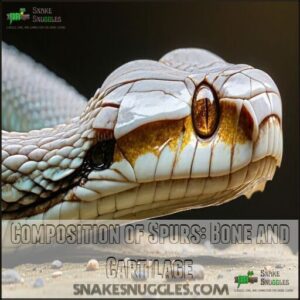This site is supported by our readers. We may earn a commission, at no cost to you, if you purchase through links.
 Spurs on snakes are tiny, claw-like structures found near the base of the tail in species like pythons and boas.
Spurs on snakes are tiny, claw-like structures found near the base of the tail in species like pythons and boas.
They’re actually leftovers from ancient hind limbs, so imagine them as a “time capsule” of evolution! These spurs, made of bone and covered in keratin, are attached to pelvic bones and muscles.
Males use them during mating to stimulate and grip females, while in some cases, they may provide extra traction for movement. Notably, spurs are typically larger in males than females, making them useful for telling the sexes apart.
Curious how snakes evolved to keep these? There’s more to uncover! Spurs are an interesting feature that can help us understand the history of snakes.
Table Of Contents
Key Takeaways
- Snake spurs are tiny, claw-like structures near the tail, remnants of ancient hind limbs, and mostly found in species like boas and pythons.
- Male snakes use spurs during mating to scratch and stimulate females, while they also aid in climbing or combat.
- Spurs are made of bone, cartilage, and keratin, with males typically having larger and more curved ones than females.
- Though small and vestigial, spurs are still functional and provide a glimpse into snakes’ evolutionary history.
Defining Snake Spurs: Anatomy and Structure
Snake spurs are small, claw-like structures found near the tail, positioned on either side of the cloaca.
Tiny claw-like spurs near a snake’s cloaca whisper secrets of evolution, blending ancient limbs with modern function.
Made of bone and cartilage with a durable keratin coating, they’re connected to the pelvis and can even move slightly thanks to specialized muscles.
Location of Spurs on Snake Bodies
When observing snake anatomy, spurs are tiny, claw-like structures located near the cloacal region, just under the tail.
These vestigial spurs are attached to the pelvis, offering a glimpse into their legged ancestors.
The spur placement is close to the cloaca, surrounded by the scales in this area, making them easy to spot if you know where to look.
Despite their small size, spurs vary by species, reflecting evolutionary differences.
Their pelvic connection makes them particularly intriguing for studying snake evolution.
Next time you encounter a boa or python, check the scale coverage near its cloaca for spurs!
Composition of Spurs: Bone and Cartilage
Snake spurs, those tiny yet fascinating structures, are all about resilience and function. They’re crafted from bone and cartilage, combining strength and flexibility.
Here’s the breakdown:
- Bony Core: This tough inner bone provides durability, making the spurs firm yet functional.
- Cartilage Function: Surrounding cartilage adds a bit of cushion and movement, ensuring flexibility during use.
- Keratin Cap: A hard, nail-like outer layer protects the spur, enabling scratching or gripping.
Spurs also regenerate their keratin caps during the shedding process, showcasing the adaptability of snake anatomy.
Variations in Spur Size and Shape
No two snake spurs are alike! Their size, shape, and curvature vary widely due to genetic factors, environmental influence, and functional morphology.
Species comparisons highlight how evolution adapted spur variation for distinct needs. For example, sturdy spurs in pythons aid courtship, while sleek designs help with climbing.
Males often boast larger, more curved spurs, a clear case of spur dimorphism. Like other reptiles, snakes use specialized sensory mechanisms for environmental awareness.
| Species | Spur Size | Spur Shape | Purpose |
|---|---|---|---|
| Pythons | Large | Sturdy | Mating |
| Boas | Medium | Curved | Display & Courtship |
| Slender Blind Snakes | Small | Straight | Navigation |
| Anacondas | Large | Sleek | Locomotion |
Attachment to Pelvis via Bones and Muscles
Connecting snake spurs to their pelvis, the pelvis-spur connection is a marvel of bone and cartilage combined with muscular structures. Though small, spurs aren’t just decorative—they’re functional! Their muscle attachment points guarantee precise movement, whether gripping during courtship or anchoring for balance.
Here’s how this intricate system operates:
- Spur movement mechanics depend on tiny, flexible muscles.
- The pelvic bone structure supports spurs efficiently.
- Connected vestigial bones remind us of evolutionary muscle changes.
- Spurs gain versatility through their secure, well-adapted design.
This showcases nature’s brilliance in designing every detail!
Protrusion During Breeding Season
During breeding season, snake spurs become more prominent, driven by hormonal influence that signals mating readiness.
For males, these pelvic spurs, connected to vestigial bones, play a key role in courtship. They use their claw-like structures for spur sensitivity, tapping or nudging females to encourage female stimulation.
Interestingly, spur size is typically larger in males, helping them achieve greater reproductive success. Females also have spurs, but these are generally smaller and less active during snake mating.
Here’s a quick comparison:
| Aspect | Male Spurs | Female Spurs |
|---|---|---|
| Size | Larger | Smaller |
| Role in Mating | High | Minimal |
| Use During Season | Courtship | Limited |
| Evolutionary Basis | Functional | Residual |
Evolution and Origin of Snake Spurs
When you look at snake spurs, you’re seeing tiny remnants of their ancient, limbed ancestors.
These claw-like structures tell a fascinating story about how snakes evolved from reptiles with legs into sleek, legless creatures, which is a fascinating story about their evolution from reptiles with legs into sleek creatures.
Vestigial Remnants of Hind Limbs
Snake spurs tell a story of limb evolution rooted in legless ancestry, with these claw-like protrusions representing vestigial bones from ancient reptiles.
Far from being decorative, these vestigial structures hint at history’s role in shaping today’s snakes. Boas and pythons wear their degenerative structures proudly, often confusing those expecting useless remnants.
Instead, they offer insight into evolutionary atavism, blending function with ancestry.
- **Functional spurs?
- Yes, these aren’t just relics—they aid movement and courtship.
- Fossil records confirm their evolution from limbed reptiles.
- Evolutionary misconceptions overlook the adaptation these spurs demonstrate.
Snake spurs are evolution’s tiny, enduring works of art.
Evolutionary Journey of Snakes
Snakes didn’t always slither; their ancestors once walked on legs. Over millions of years, snakes traded these ancestral limbs for streamlined bodies ideal for burrowing and climbing.
This fascinating transformation highlights evolutionary tradeoffs shaping them into today’s sleek creatures. Spurs, those tiny claw-like structures near the tail, mark that journey. Once functional hind limbs, these vestigial structures adapted into specialized tools.
Here’s how limb evolution unfolded:
- Early reptiles relied on legs for walking and hunting.
- Changing environments favored smoother, legless adaptation for agility.
- Ancestral limbs shrank, leaving vestiges like spurs in modern snakes.
- Spur development shows nature’s genius in repurposing evolutionary remnants efficiently.
Snake evolution truly showcases nature’s resourcefulness!
Challenging Darwin’s Vestigial Legs Claim
Snake spurs often spark debates. While Darwin labeled them "vestigial structures," calling them leftovers from leg evolution, modern research paints a different picture.
Spurs showcase functionality, engaging in mating, climbing, and battles, contradicting notions of degeneration. Their complex attachment system, supported by bones and muscles, further challenges the idea of evolutionary loss.
Some snakes still possess tiny vestigial leg remnants near their tails.
Here’s a quick look:
| Topic | Insight | Key Example |
|---|---|---|
| Spurs Functionality | Aid mating, grip climbing | Male pythons during courtship |
| Complex Attachment | Spurs anchored via pelvis | Movable due to musculature |
| No Degeneration | Maintain bone-muscle systems | Boas’ mating success |
Snake spurs argue against classic Darwinism, hinting at evolutionary complexity.
Specialized Adaptation Vs. Evolutionary Loss
While once thought to be useless vestigial structures, snake spurs reveal nature’s knack for innovation rather than evolutionary loss or degeneration.
These tiny, claw-like pelvic spurs serve specialized functions, emphasizing their adaptive significance in survival and reproduction.
Here’s how spurs truly shine:
- Mating Support: Male spurs deliver subtle “signals,” boosting courtship and mating success.
- Locomotion Aid: Spurs grip effectively on branches and rough terrain, adding mobility where it counts.
- Evolutionary Toolset: Their consistent functionality challenges oversimplified just-so stories about snake evolution, spotlighting how spurs evolved for modern usage.
Snake spurs blend evolutionary biology with impressive practicality!
Comparison Across Different Snake Species
Across snake species, spur presence showcases fascinating diversity. For example, python spurs often stand out, while boa constrictors show subtle size variations tied to evolutionary pressures.
Functional diversity emerges, as some use spurs for climbing or mating. Meanwhile, advanced species like colubrids completely lack spurs, shedding these vestigial clues to snake evolution.
These differences reflect nature’s adaptable blueprint across snake evolution.
Functions and Purposes of Snake Spurs
You’ll find that snake spurs play essential roles in movement, mating, and maintaining grip, offering surprising functionality for such small structures.
These bony extensions help some snakes climb trees, engage in courtship, and assist males during breeding by stimulating females, which is a crucial aspect of their mating.
Aiding in Locomotion and Tree Climbing
When living high above ground, some arboreal snakes rely on pelvic spurs to master climbing.
These small, claw-like appendages provide essential grip enhancement, helping snakes anchor themselves to rough bark or tight branches where smooth scales might slip.
Their climbing adaptations allow arboreal species, like the Madagascan boa, to navigate complex canopies efficiently.
Spurs act as locomotion assistance, especially during vertical climbing, offering stability and control.
Notably, even ground snakes like burrowers use them for tunnel gripping, showing the versatile role of snake spurs in adapting to life’s varied physical challenges.
Role in Mating Rituals and Courtship
During mating season, snake spurs turn into impressive tools of courtship.
Snake spurs become nature’s gentle tools for romance, sparking connection and ensuring survival through ancient, silent courtship dances.
Male snakes use these small, claw-like structures to initiate intricate mating rituals that showcase their strength and charm. These spurs, connected to the pelvis, play a critical role in courtship behaviors, which can substantially influence reproductive success.
Here’s what their display often includes:
- Gentle tapping: Males flick their spurs along the female’s body to attract attention.
- Tail vibrations: Rhythmic movements signal dominance and readiness to mate.
- Body contact: Chin-rubbing and spur movements emphasize connection.
- Tactile stimulation: Subtle coital bites help evoke female stimulation.
These courtship behaviors highlight sexual dimorphism, as males actively use spurs for mating rituals, enhancing their evolutionary success.
Stimulating Females During Breeding
During breeding, snake spurs become essential tools of courtship. Male snakes use these small, claw-like structures near their cloacas to gently scratch and stroke females.
This “courtship scratching” triggers hormonal changes, encouraging receptivity and the release of sex pheromones. Think of it as a non-verbal way to express readiness for mating—an ancient yet effective language of reproduction.
Larger spurs often prove more effective, as they amplify stimulation and boost reproductive success. These sensitive appendages are carefully maneuvered, showcasing the male’s intent while increasing mating frequency.
Understanding snake reproductive anatomy is essential for successful breeding.
-
How spurs work in courtship:
- Gently scratching triggers pheromone release.
- Hormonal influence promotes receptivity in females.
- Stimulating spurs enhance mating rituals and success rates.
Snake spurs clearly play a pivotal role in breeding.
Maintaining Grip While Hunting
Snake spurs act like grappling hooks during hunting, offering Ambush Stability and Terrain Adaptation.
Arboreal species, for instance, fine-tune their grip as they strike prey unseen among branches. Spurs also enhance snake locomotion, improving Prey Handling and Constriction Assistance.
| Feature | Role | Benefit | Example |
|---|---|---|---|
| Spurs | Grip enhancement | Ambush Stability | Arboreal snakes |
| Anatomy | Grappling structure | Assists in Prey Handling | Boas, pythons |
| Camouflage | Hunts unseen | Improves Evolutionary Advantage | Treetop predators |
| Locomotion | Support climbing | Essential Terrain Adaptation | Reptile anatomy |
Differences Between Male and Female Spurs
You might’ve spotted male vs. female differences in snake spurs if you’ve looked closely.
Male spurs stand out—they’re larger, more curved, and made for courtship, perfect for gripping during breeding. Females’ spurs are smaller, less curved, and rarely used.
According to forum statistics, there were 713 online users recently.
- Spur size: Males dominate in spur dimensions.
- Spur shape: Curved male spurs aid mating.
While helpful, sexing snakes by spurs has limitations. Dimorphism variations mean spur size alone isn’t foolproof for determining sex.
Snake Species With and Without Spurs
Some snakes, like boas and pythons, have noticeable spurs near their tails, which play roles in mating and combat.
Other species, such as corn snakes, completely lack these structures, reflecting differences in evolutionary traits.
Spurs in Boas and Pythons
Boas and pythons have unique pelvic spurs, small claw-like structures near their cloaca.
These vestigial structures aren’t just evolutionary leftovers—they’re surprisingly functional.
Males use their larger, curved spurs to scratch females during mating combat and courtship.
In arboreal pythons, spurs improve climbing by stabilizing the body against tree branches.
Here’s what makes Boa spurs and Python spurs fascinating:
- Sexual dimorphism: Male spurs outsize females’ for better mating use.
- Versatile tools: Help in climbing or gripping.
- Evolutionary markers: Reflect adaptation over time.
Presence of Spurs in Anacondas
If you’ve ever wondered about the intriguing features of anacondas, snake spurs might surprise you.
These small, claw-like structures near their tails serve essential purposes beyond being evolutionary leftovers. With Anaconda Spur Size, males have larger spurs, perfect for courtship, where they gently nudge and stimulate females during mating.
But that’s just scratching the surface.
Spurs help with climbing and gripping vegetation in their aquatic habitats, showcasing their Habitat Spur Use.
Crafted from bone, cartilage, and a keratin cap, spurs even regenerate as part of shedding cycles. Their snake anatomy proves these spurs are indispensable.
From Anaconda Sexing Spurs to their genetic spur factors, anacondas’ adaptations underscore their survival brilliance.
Corn Snakes and Their Spur Characteristics
Corn snake spurs, though small and often overlooked, are fascinating features that hint at their evolutionary history. Found near the cloaca, these spurs vary in size, with males typically having more noticeable ones.
During courtship, male corn snakes use spurs to gently stimulate females, showcasing their unique spur functionality.
Here’s what makes corn snake spurs interesting:
- Located near the tail’s vent.
- Made of bone with a keratin cap.
- Spurs vary by size and shape across snakes.
- More visible during the breeding season.
- They often shed with scales.
The characteristics of corn snake spurs, including their location, composition, and variation, contribute to their fascinating features.
Spurs in Slender Blind Snakes
Slender blind snakes are tiny burrowers with delicate snake spurs that reveal their evolutionary significance.
These reptile spurs are small yet essential, aiding in their underground navigation and sensory perception. Anchored near the cloaca, these vestigial structures showcase fascinating spur functionality.
- Underground Navigation: Spurs help slender blind snakes maneuver dense, rocky habitats effectively.
- Evolutionary Significance: They hint at ancient limb remnants while adapting to modern needs.
- Sensory Functionality: Spurs may provide tactile feedback, guiding these nearly blind snakes underground.
Snake Species Lacking Spurs
Not all snakes carry spurs, and that’s where evolution gets creative.
Many species, like colubrids, brilliantly showcase legless adaptation. A few boas and blind snakes have also shed these reptile spurs over time, favoring streamlined designs.
Spurless snakes reflect advanced evolution, trading leftover "legs" for flexibility and speed. Without primitive features, they’re an indication of modern snake diversity.
Here’s a comparison:
| Category | With Spurs | Without Spurs |
|---|---|---|
| Pelvic Spur Location | Near cloaca | Absent |
| Purpose | Mating, climbing | N/A |
| Examples | Boas, pythons | Colubrids, blind snakes |
| Evolution Stage | Primitive snakes | Advanced evolution |
| Adaptation Type | Remains of snake legs | Legless adaptation benefits |
These spurless wonders highlight evolution’s resourceful nature brilliantly.
Spur-related Sex Determination in Pythons
You can often identify a python’s sex by examining the size and shape of its spurs, as males typically have larger, more curved spurs compared to females.
While this method provides helpful clues, variability among individuals means it’s not always a reliable approach.
Spur Size and Shape Differences
Snake spurs are fascinating because their size and shape can vary so much, even within the same species.
For pythons, these tiny claw-like structures offer insightful Male vs. Female comparisons and show how genetics and environment influence spur functionality.
Let’s break it down:
- Size Differences: Male python spurs are often larger than females’, reflecting their role in courtship and competition.
- Shape Variety: The spur shape can differ, influenced by environmental factors or genetic variations, sometimes resulting in curved or straighter forms.
- Species Diversity: Even snakes of the same species may have noticeable spur size distinctions.
- Function Impact: A spur’s size and shape often tie to its functionality in mating or movement, showing its practical role in snake behavior.
Still, exceptions exist depending on genetics and species comparison patterns.
Spur Placement Relative to Cloacal Scale
Snake spurs hold secrets about gender when observed near the cloacal scale—small details can reveal big insights.
The placement of these structures varies between male and female pythons.
- Males: Spurs are more prominent and positioned laterally near the vent. They extend distally with minimal scale overlap, creating a narrow spur-cloaca gap.
- Females: Their spurs are smaller, tucked closer to the body, with limited lateral reach. This results in a more symmetrical pairing with surrounding snake scales.
By evaluating spur symmetry and proximity to the cloacal scale, you can engage in a fascinating species comparison, decoding traits influenced by evolutionary significance. However, remember that these genetic factors vary, so interpretation isn’t always foolproof!
Limitations of Using Spurs for Sexing
Pinpointing a snake’s sex with spurs alone feels like solving a jigsaw puzzle with missing pieces. While male pythons often have larger, more curved spurs, size alone isn’t a consistent indicator.
Females can have smaller, thinner spurs, adding to the confusion. Spur variability and inconsistent indicators make relying solely on this trait risky.
Misidentification risks increase without additional snake sexing tools or alternative methods. Since snake spurs are vestigial and vary widely, they should be viewed as one part of the sexing equation.
Other methods, such as tail length observation, can provide additional clues. Experts recommend combining spur size observations with other approaches to avoid sexing errors.
Ultimately, expert dependence guarantees accuracy, as spurs alone often leave questions unanswered, highlighting the need for alternative methods and a comprehensive approach to ensure accurate identification.
Alternative Methods: Probing and Breeding Behavior
Checking a python’s sex goes beyond spur size.
Probing methods offer accuracy, but it’s best left to experts—using a smooth probe, they measure hemipenis depth inside the cloaca.
For a hands-off approach, observe these behavioral cues:
- Mating Observation: Watch for courtship movements like tail wraps.
- Spur Interaction: Males often use spurs to stimulate females.
- Behavioral Cues: Note territorial moves or dominance displays.
- Expert Confirmation: Combine observations with professional advice for sexing reliability.
The process may require a python sexing probe for accuracy.
Snake breeding thrives on understanding these fascinating patterns!
Importance of Expert Examination for Accuracy
Experts are your go-to for reliable identification in the area of snake morphology and sex determination.
Misinterpreting spur size, shape, or placement can lead to misidentification. Herpetologists rely on tools and detailed anatomical knowledge to minimize errors.
Imagine inspecting a fingerprint—each snake’s spurs tell a unique story. Here’s a glimpse of expert evaluation:
| Aspect | What Experts Check |
|---|---|
| Spur Size | Male vs. female dimensional clues |
| Spur Placement | Relation to cloacal scale |
| Pelvic Structures | Evolutionary traits or remnants |
| Muscle Attachments | Functional mobility and purpose |
Trust a pro—guesswork doesn’t belong in species verification. Understanding spur identification products can also be helpful.
Frequently Asked Questions (FAQs)
What are snake Spurs?
Spurs are small, claw-like structures near a snake’s tail, made of bone and keratin.
Found on some species like boas and pythons, they’re remnants of hind limbs used in mating, combat, or climbing.
Do male snakes have spurs?
Think of male snakes like ancient warriors with hidden weapons—yes, they’ve spurs.
These small, claw-like structures near their tails play a critical role in courtship, combat, and mating, particularly for boas and pythons.
What is a pelvic spur in a snake?
A pelvic spur in a snake is a small, claw-like structure near its tail, linked to the pelvis.
It’s a vestige of ancient legs, now used mainly for mating, combat, and climbing.
How do snakes use their spurs?
Imagine snake spurs as multitools.
Males use them to woo females by scratching during mating, sparking courtship.
They’re also handy for climbing, gripping surfaces, and male-to-male combat, proving they’re both romantic and practical!
What is a spur in a Python?
In pythons, a spur is a small, claw-like structure near the tail, just outside the cloaca.
It’s used for courtship, gripping, and combat.
These vestigial remnants of ancient legs are more prominent in males.
What are snake Spurs made of?
Snake spurs are made of bone, cartilage, and a keratin coating.
The bony core is connected to the pelvis, while the tough keratin cap, similar to a fingernail, provides durability and even regrows after damage.
Can female snakes have spurs?
Imagine this—a snake with tiny, secret weapons.
Yes, female snakes can have spurs!
These small, claw-like structures near the tail aren’t just for males.
Though often smaller in females, they still serve specific roles like climbing or courtship.
What do cloacal spurs do?
Cloacal spurs help snakes with mating, fighting, and climbing.
Males use them to scratch females during courtship, compete with rivals, and grip surfaces.
Though small, these claw-like structures are surprisingly versatile and practical, making them a crucial tool for snakes, with complete concepts of their use being highly beneficial.
Do snakes shed their spurs?
Like trees shedding old leaves, snakes shed their spurs’ outer keratin caps during ecdysis.
These claw-like structures naturally renew as part of their growth, ensuring they stay functional for matting, climbing, or other uses, but more accurately, they are used for climbing.
Why do snakes have horny spurs?
Horny spurs help snakes with mating and fighting.
Males use them to scratch females during courtship or challenge rivals in combat.
These specialized claw-like structures enhance reproduction and are remnants of their evolutionary ancestors’ limbs, which can be considered key to understanding their evolutionary history.
Conclusion
Keeping an eye on the bigger picture, spurs on snakes offer a fascinating glimpse into their evolutionary past while serving practical purposes today.
These small, claw-like structures, remnants of ancient hind limbs, play roles ranging from aiding male snakes during mating to helping with movement.
Found in species like boas and pythons, spurs vary in size, typically being larger in males.
Understanding what spurs on snakes are reveals insights into their anatomy, evolutionary journey, and behavior.



















